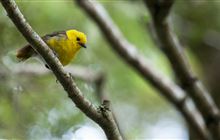Melodic mohua on the move
Archived content: This media release was accurate on the date of publication.
Introduction
100 mohua have been translocated from Anchor Island in Dusky Sound to the Eglinton Valley.Date: 10 October 2017
Birdsong in the Eglinton Valley has become that much sweeter after 100 mohua were released at Kiosk Creek on Friday.
The mohua, which were translocated from Anchor Island in Dusky Sound, will join a population that’s been slowly increasing in the valley since intensive predator control was introduced in 2009.
This was the fourth mohua translocation to the area in seven years in a joint effort by the DOC, the Mohua Charitable Trust and with support from Ngāi Tahu.
DOC’s biodiversity ranger Rebecca Jackson says mohua, which were known as bush canaries by early settlers thanks to their melodic song, were once almost functionally extinct in the area.
“Mohua were once common in the valley – we estimate there could have been hundreds of them. However, rat and stoat predation saw the population plummet and by the early 2000s, there was just 18 mohua in the whole valley. Through a combination of translocations and pest management the number of mohua has increased, with 171 found in the valley last autumn”.
Now, thanks to intensive pest management – including a combination of traps, bait stations and aerial 1080 – the area has become a mainland stronghold for a variety of endangered native species including mohua, long and short-tailed bats, kākā and kākāriki.
To maintain this DOC keeps a close eye on rodent numbers to make sure they don’t reach levels that are damaging to flora and fauna, Rebecca Jackson says.
This spring DOC is undertaking rat control over 4,800 ha of the Eglinton Valley using hand laid poison pindone in bait stations to reduce rat numbers as part of the Battle for our Birds operations.
“While the area was included in the 2016 Battle for our Birds operations which were successful in knocking rat numbers down to about 3% on the tracking index, recent monitoring has shown in some places rat numbers have crept back to above threshold levels. We want to take proactive, preventative measures to control rat numbers during the time they are most likely to be the biggest threat to our birds.”
“This will ensure the newly resident mohua, and all other native birds and bats in the area, will have the best chance at breeding and nesting success over the summer.”
Mohua Charitable Trust Founder Nigel Babbage says after sponsoring the first mohua translocation to the Eglinton valley in 2010, it was great to be able to continue to support the population.
“We’re thrilled to be bringing back the birdsong to this beautiful area.”
Contact
For media enquiries contact:
Email: media@doc.govt.nz

